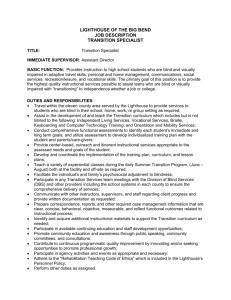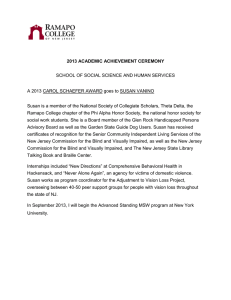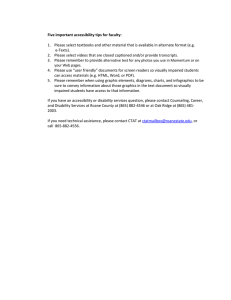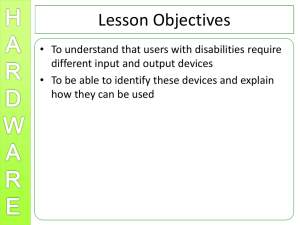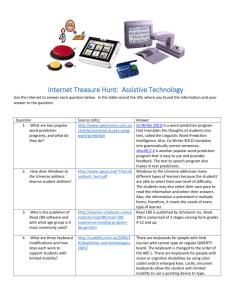REHABILITATION AND HABILITATION OF THE VISUALLY IMPAIRED Describe the use of Adaptive
advertisement
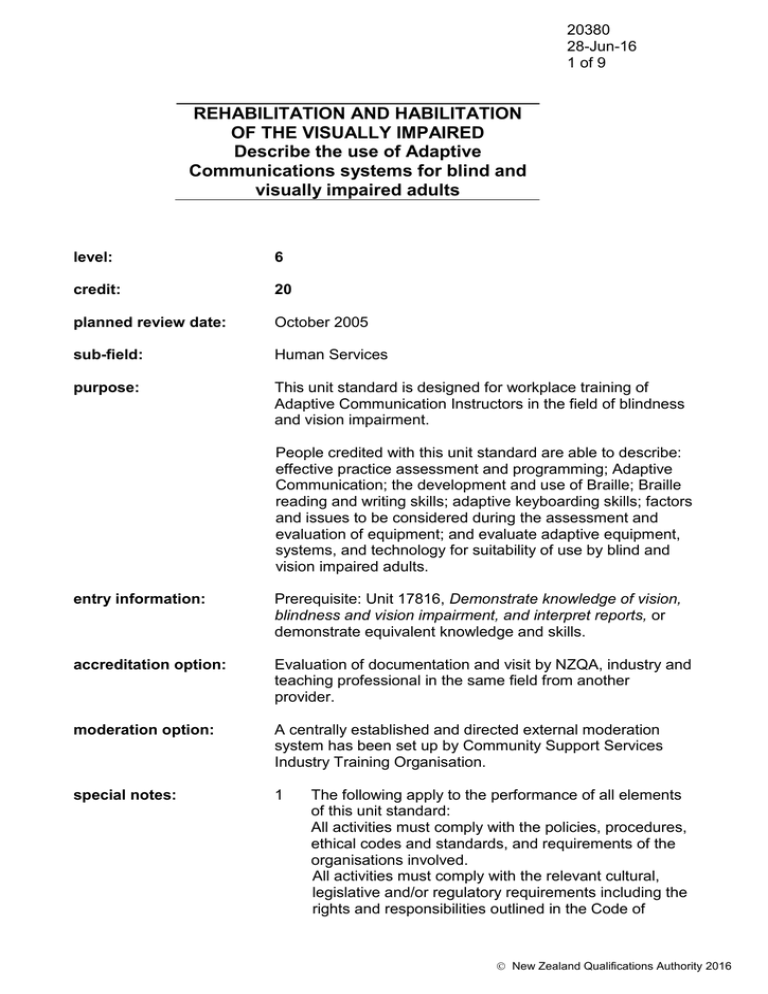
20380 28-Jun-16 1 of 9 REHABILITATION AND HABILITATION OF THE VISUALLY IMPAIRED Describe the use of Adaptive Communications systems for blind and visually impaired adults level: 6 credit: 20 planned review date: October 2005 sub-field: Human Services purpose: This unit standard is designed for workplace training of Adaptive Communication Instructors in the field of blindness and vision impairment. People credited with this unit standard are able to describe: effective practice assessment and programming; Adaptive Communication; the development and use of Braille; Braille reading and writing skills; adaptive keyboarding skills; factors and issues to be considered during the assessment and evaluation of equipment; and evaluate adaptive equipment, systems, and technology for suitability of use by blind and vision impaired adults. entry information: Prerequisite: Unit 17816, Demonstrate knowledge of vision, blindness and vision impairment, and interpret reports, or demonstrate equivalent knowledge and skills. accreditation option: Evaluation of documentation and visit by NZQA, industry and teaching professional in the same field from another provider. moderation option: A centrally established and directed external moderation system has been set up by Community Support Services Industry Training Organisation. special notes: 1 The following apply to the performance of all elements of this unit standard: All activities must comply with the policies, procedures, ethical codes and standards, and requirements of the organisations involved. All activities must comply with the relevant cultural, legislative and/or regulatory requirements including the rights and responsibilities outlined in the Code of New Zealand Qualifications Authority 2016 20380 28-Jun-16 2 of 9 REHABILITATION AND HABILITATION OF THE VISUALLY IMPAIRED Describe the use of Adaptive Communications systems for blind and visually impaired adults Health and Disability Services Consumers’ Rights 1996, and the Health and Safety in Employment Act 1992, and their subsequent amendments. 2 Definitions Organisational standards refer to the procedures regarded as effective practice by the Royal New Zealand Foundation for the Blind (RNZFB) or equivalent professional organisations, and includes compliance with in-house rules and regulations, and specific data collection systems. Consumer refers to an individual who meets current RNZFB or equivalent professional organisation membership criteria. Blindness, visual impairment, and vision impairment refer to the functional state of meeting current definitions of membership of the RNZFB or equivalent professional organisations. Workplace refers to the RNZFB or equivalent specialist professional organisation contexts of service delivery. 3 Assessment information The knowledge and skills evidence in this unit standard must be consistent with current industry texts and documented RNZFB or equivalent professional organisation competency criteria. The assessment must ensure the privacy and rights of people who have disabilities will be respected at all times. New Zealand Qualifications Authority 2016 20380 28-Jun-16 3 of 9 REHABILITATION AND HABILITATION OF THE VISUALLY IMPAIRED Describe the use of Adaptive Communications systems for blind and visually impaired adults Elements and Performance Criteria element 1 Describe effective practice assessment and programming used in vision rehabilitation and habilitation. performance criteria 1.1 Characteristics of effective practice assessment and programming are described in accordance with organisational standards. Range: 1.2 Factors influencing effective practice assessment and programming are identified and described in accordance with organisational standards. Range: 1.3 evidence is required for at least five characteristics. evidence is required for at least six factors. Effective practice assessment approaches are compared and described in accordance with organisational standards. Range: effective practice assessment approaches may include but are not limited to - medical, behavioural, developmental, clinical, standardised, non standardised; evidence is required for at least five approaches. element 2 Describe Adaptive Communication in relation to vision rehabilitation and habilitation. performance criteria 2.1 The history relating to Adaptive Communication is described in terms of 19 th, 20th, and 21st century development of services for persons with blindness, vision impairment, and deaf/blind. Range: international, national. New Zealand Qualifications Authority 2016 20380 28-Jun-16 4 of 9 REHABILITATION AND HABILITATION OF THE VISUALLY IMPAIRED Describe the use of Adaptive Communications systems for blind and visually impaired adults 2.2 Current services offered by the RNZFB are described in terms of their relationship with Adaptive Communication. Range: 2.3 Community services are described in terms of their relationship with Adaptive Communication. Range: 2.4 may include but is not limited to - core components, boundaries, referral systems, services under development, processes; evidence is required for a minimum of six services. may include but is not limited to - contact process, current services offered, core components, role, boundaries, referral or contact process, rationale for referral; evidence is required for a minimum of four agencies. The principles of Identification, Organisation, and Labelling are described in relation to Adaptive Communication. Range: Identification - use of four sensory areas; Organisation - grouping, location, placement; Labelling - tactile, visual, auditory. element 3 Describe the development and use of Braille. performance criteria 3.1 Braille is described in terms of the history up to current Braille use. Range: 3.2 Louis Braille, English Braille, Braille in New Zealand. Factors that influence a consumer’s decision to use Braille are described in accordance with organisational standards. Range: includes but is not limited to - personal, social, environmental; evidence is required for at least two examples relating to each factor. New Zealand Qualifications Authority 2016 20380 28-Jun-16 5 of 9 REHABILITATION AND HABILITATION OF THE VISUALLY IMPAIRED Describe the use of Adaptive Communications systems for blind and visually impaired adults 3.3 Teaching resources and courses available through the RNZFB are described in terms of their applications, advantages, and disadvantages. Range: 3.4 Braille codes are described in terms of their applications, advantages, and disadvantages. Range: 3.5 Nemeth, computer Braille, music. Alternative tactile codes are described and evaluated in terms of their applications, advantages, disadvantages, and strategies for teaching. Range: 3.6 includes but is not limited to - RNZFB Keeping in Touch (Kit), RNZFB Braille reading and writing, Braille teaching schemes, RNZFB touch typing courses. Fishburn, Moon, Jumbo Braille. Braille production systems are described and evaluated in terms of the applications, advantages, disadvantages, rationale for use, and strategies for teaching. Range: electronic, manual, mechanical. element 4 Describe skills required for reading and writing Braille. performance criteria 4.1 Braille readiness activities are described in terms of application issues, potential constraints, rationale for use, and strategies for teaching. 4.2 Braille codes are described in terms of application issues, potential constraints, rationale for use, and strategies for teaching. Range: Grade 1 Braille, Grade 2 Braille. New Zealand Qualifications Authority 2016 20380 28-Jun-16 6 of 9 REHABILITATION AND HABILITATION OF THE VISUALLY IMPAIRED Describe the use of Adaptive Communications systems for blind and visually impaired adults 4.3 Skills required for reading Braille are identified and described in terms of application issues, potential constraints, rationale for use, and strategies for teaching. Range: 4.4 evidence is required for at least five skills. Skills required for writing Braille are identified and described in terms of organisational standards. Range: evidence is required for at least three skills. element 5 Describe adaptive keyboarding skills used for vision rehabilitation and habilitation. performance criteria 5.1 Adaptive keyboarding techniques are identified and described in terms of application issues, potential constraints, rationale for use, and strategies for teaching. Range: 5.2 Identification and Labelling techniques used for adaptive keyboarding are described and evaluated in accordance with organisational standards. Range: 5.3 evidence is required for at least three techniques. includes but is not limited to - marking keyboard, end of paper; evidence is required for at least three principles across a range of senses. Adaptive keyboarding resources for teaching blind adults are identified and described in terms of application issues, potential constraints, rationale for use, and strategies for teaching. Range: evidence is required for two touch keyboarding courses, one of which is a RNZFB touch typing course. New Zealand Qualifications Authority 2016 20380 28-Jun-16 7 of 9 REHABILITATION AND HABILITATION OF THE VISUALLY IMPAIRED Describe the use of Adaptive Communications systems for blind and visually impaired adults element 6 Describe and evaluate the suitability of Adaptive Communications systems for blind and vision impaired adults. performance criteria 6.1 Adaptive handwriting equipment is identified and evaluated in terms of its suitability for blind and vision impaired adults. Range: 6.2 Adaptive listening and recording equipment is described and evaluated in terms of its suitability for blind and vision impaired adults. Range: 6.3 evidence is required for at least three forms of equipment. must include - voice organisers, dictaphones, cassette recorders and one other. Adaptive calculation equipment is described and evaluated in terms of its suitability for blind and vision impaired adults. Range: evidence is required for at least two forms of equipment. element 7 Describe and evaluate the suitability of Adaptive Technology for blind and vision impaired adults. performance criteria 7.1 Adaptive computer software is described and evaluated for suitability for communication instruction for blind and vision impaired adults. Range: 7.2 screen reading, large image, speech output. Electronic note taking devices are described and evaluated for their suitability for blind and vision impaired adults. Range: evidence is required for two notetaking devices. New Zealand Qualifications Authority 2016 20380 28-Jun-16 8 of 9 REHABILITATION AND HABILITATION OF THE VISUALLY IMPAIRED Describe the use of Adaptive Communications systems for blind and visually impaired adults 7.3 Optical character recognition devices are described and evaluated for their suitability for blind and vision impaired adults. Range: evidence is required for two optical character recognition devices. element 8 Describe factors and issues to be considered during the assessment and evaluation of equipment for blind and vision impaired adults. performance criteria 8.1 Factors that contribute to effective assessment and evaluation of equipment for blind and vision impaired adults are described in accordance with organisational standards. Range: 8.2 evidence required for at least three factors. Issues that can influence effective assessment and evaluation of equipment for blind and vision impaired adults are identified and described in accordance with organisational standards. Range: social, environmental, personal. Comments on this unit standard Please contact the Community Support Services Industry Training Organisation enquiries@cssito.org.nz if you wish to suggest changes to the content of this unit standard. Please Note Providers must be accredited by the Qualifications Authority or a delegated interinstitutional body before they can register credits from assessment against unit standards or deliver courses of study leading to that assessment. Industry Training Organisations must be accredited by the Qualifications Authority before they can register credits from assessment against unit standards. New Zealand Qualifications Authority 2016 20380 28-Jun-16 9 of 9 REHABILITATION AND HABILITATION OF THE VISUALLY IMPAIRED Describe the use of Adaptive Communications systems for blind and visually impaired adults Accredited providers and Industry Training Organisations assessing against unit standards must engage with the moderation system that applies to those standards. Accreditation requirements and an outline of the moderation system that applies to this standard are outlined in the Accreditation and Moderation Action Plan (AMAP). The AMAP also includes useful information about special requirements for providers wishing to develop education and training programmes, such as minimum qualifications for tutors and assessors, and special resource requirements. This unit standard is covered by AMAP 0024 which can be accessed at http://www.nzqa.govt.nz/site/framework/search.html. New Zealand Qualifications Authority 2016

